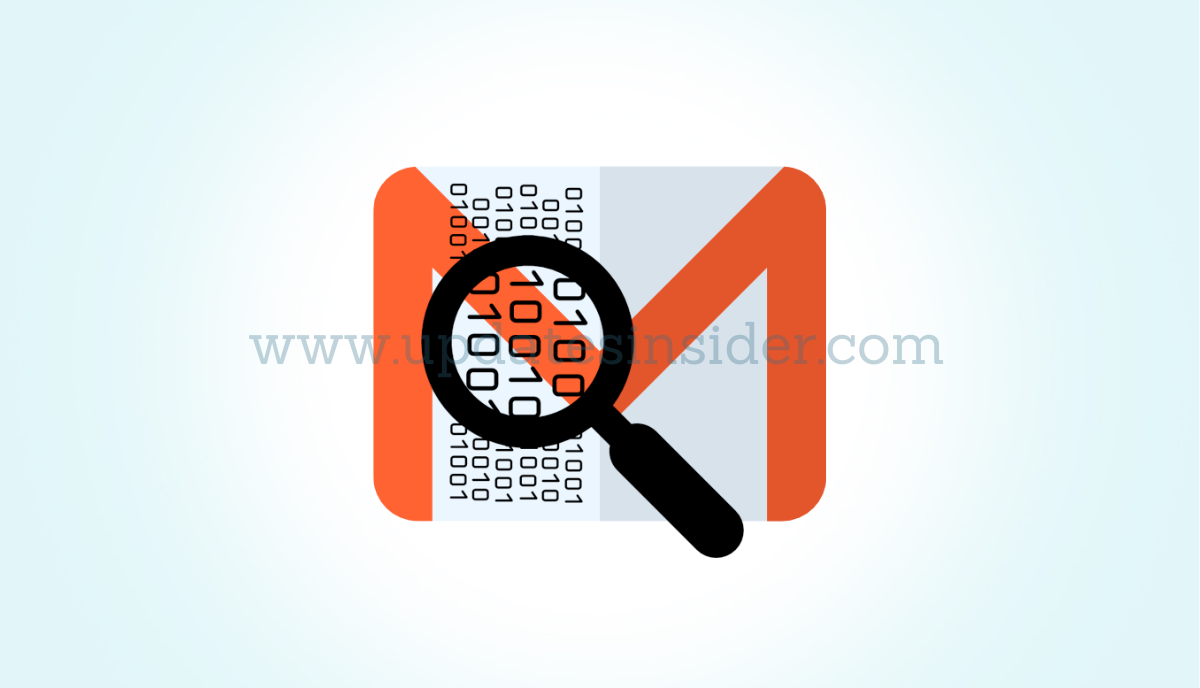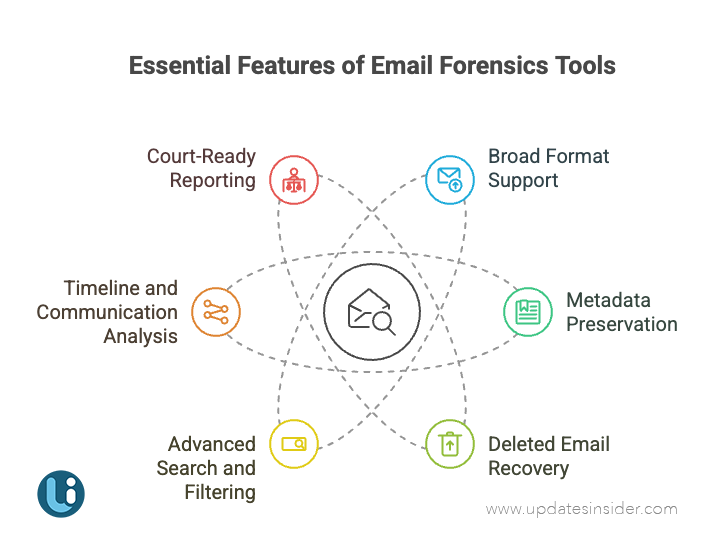Email Forensics Software – Collects Data Other Tools Miss

Think about it. Every deal closed, every dispute raised, every fraud covered up—so often, it leaves a trace in someone’s inbox. Emails are more than just casual messages. They’re modern-day records, time-stamped and packed with details people don’t always realize they’re leaving behind.
Now picture this: an investigator is stuck on a financial fraud case. Months of paper trails go nowhere. But then, one “deleted” email is recovered. Inside it lies the exact instruction that unravels the entire scheme. That single email flips the case.
This is why email forensics matters. It’s not just about digging through inboxes—it’s about treating them like digital crime scenes. And here’s the thing: you can’t rely on normal search or IT tools for this job. You need specialized email forensics tools that preserve evidence, recover hidden data, and make sure nothing gets lost in translation when it’s time to present findings in court.
In this guide, we’ll break down what makes email forensics tools essential, the features that actually matter, and a closer look at some of the leading options used by professionals today.
What Is Email Forensics?
At its core, email forensics is the science of uncovering the truth inside emails. It’s not about just scrolling through an inbox. It’s about analyzing the who, when, where, and how behind every message.
Here’s a simple way to see it. Imagine an inbox as a crime scene. The subject line is the headline on the newspaper. The body of the email is the obvious evidence, like fingerprints on the table. But the real gold? It’s in the metadata—the hidden details tucked behind the message. Things like sender IP addresses, timestamps, server hops, or whether the email was forwarded or tampered with.
This is why investigators don’t rely on basic mail clients like Outlook or Gmail search. Regular tools can show you the surface. Forensics tools dig deeper. They can:
- Recover “deleted” emails that people thought were gone forever
- Trace where an email really came from
- Extract attachments and see if they’ve been altered
- Preserve everything in a way that holds up in court
What this really means is that email forensics isn’t just digital archaeology. It’s active detective work that turns scattered conversations into a chain of evidence.
Core Features of Email Forensics Tools
Not all tools are created equal. Some just skim the surface, while the stronger ones dig into every corner of an inbox. If you’re evaluating email forensics tools, here are the features that matter most.

1. Broad format support
Emails don’t come in one flavor. You’ll see PST and OST from Outlook, MBOX from Thunderbird, EML files, webmail exports, even archives from platforms like Google Vault. A good tool handles them all without breaking a sweat.
2. Metadata preservation
Think of metadata as the digital fingerprint on an email. It tells you when a message was sent, from where, through which servers, and whether it was read or forwarded. If a tool can’t preserve metadata exactly as it is, evidence risks becoming useless in court.
3. Deleted email recovery
People often think deleting an email makes it disappear. It doesn’t. The right forensics software can recover “double-deleted” emails, even from corrupted mailboxes or unallocated disk space.
4. Advanced search and filtering
When investigators are sitting on millions of emails, keyword search isn’t enough. The best tools offer Boolean searches, timeline filters, multilingual support, and even AI-powered classification to pinpoint exactly what matters.
5. Timeline and communication analysis
It’s not just about single emails—it’s about patterns. Who talked to who, when, and how often. Some tools let you visualize connections like a map of conversations.
6. Court-ready reporting
All the evidence in the world is useless if you can’t present it properly. The strongest tools export to formats like PDF, CSV, or PST while preserving folder structures, attachments, and metadata. Reports need to be clean, detailed, and admissible in court.
These features are the difference between “just searching emails” and running a forensic-grade investigation that stands up under scrutiny.
Top Email Forensics Tools to Know
There are plenty of tools out there, but a few stand out for their reliability and depth. Let’s look at the ones professionals actually trust in the field.
MailXaminer
MailXaminer is built with investigators in mind. It supports a wide range of formats—PST, OST, MBOX, EML, OLM, and more—so it can handle data no matter where it comes from. One of its strengths is advanced search: it doesn’t just stop at keywords but lets you filter by metadata, attachments, and even apply timeline analysis to piece together events.
Another highlight is communication visualization. Instead of staring at raw email threads, you can see a graph of who’s been in touch with whom, and how often. That’s invaluable when trying to spot hidden relationships in a case. MailXaminer also exports evidence in multiple formats, making it easy to submit reports that hold up in legal proceedings.
Core Features of MailXaminer
- Powerful search with multiple options & logical operators
- Link analysis to detect connections between emails
- OCR to search text in images or attachments
- Timeline analysis with graphical email frequency view
- Word cloud for visual word frequency representation
- Geolocation image mapping with latitude/longitude/altitude
- Entity analysis to detect locations and usage frequency
- Skype database analysis for calls, chats, and communications
- IP analysis of emails (Yearly Subscription only)
- URL safety check with advanced analysis (Yearly Subscription only)
- Detailed email header analysis
- Rules configuration to auto-filter, search, or tag emails
Best for: Large investigations needing advanced analytics and visualizations.
4n6 Email Forensics Tool
The 4n6 Email Forensics Tool focuses on simplicity while still offering powerful features. It opens and analyzes dozens of email file types, from common formats like PST and MBOX to less common ones. Its strength lies in detailed email header and metadata analysis—perfect when you need to trace the path of a suspicious message or confirm authenticity.
Investigators also like its export flexibility. You can save evidence in PDF, CSV, HTML, and more, while preserving folder structure and integrity. It’s a lighter tool compared to MailXaminer but often faster to deploy for straightforward cases.
Best for: Investigators who want speed, clear reporting, and strong metadata analysis.
Aid4Mail (Alternative to Consider)
While our focus is on MailXaminer and 4n6, it’s worth noting Aid4Mail. Known for speed and accuracy, Aid4Mail handles terabytes of email data while preserving integrity. It’s especially strong at recovering deleted messages and supports advanced search with AI-powered filtering. Many professionals use it alongside other forensic suites for complex cases.
Best for: High-volume email collections and cases needing advanced filtering.
Together, these tools show the range: MailXaminer for deep analysis, 4n6 for quick and efficient casework, and Aid4Mail for high-speed large-scale investigations.
Choosing the Right Tool
Here’s the thing: there isn’t a single “best” email forensics tool. The right choice depends on what kind of investigation you’re running and what resources you have.
Case size and complexity
- If you’re handling thousands of emails across multiple formats, MailXaminer shines with its visualization and deep analytics.
- For smaller but detail-heavy cases, 4n6 is often enough—it’s faster to set up and gives you clear metadata insights without the extra layers.
Budget considerations
- Licensing can add up quickly. 4n6 usually comes in at a lower entry cost, while MailXaminer justifies its price with more advanced features.
- Larger agencies often combine tools, using Aid4Mail for fast data collection and MailXaminer for the analysis.
Ease of use
- If your team has seasoned forensic analysts, they’ll likely appreciate the advanced filters and network visualizations in MailXaminer.
- If you need something straightforward for quick turnarounds, 4n6 has the lighter learning curve.
Reporting needs
- Court cases demand clean, admissible reports. Both tools preserve metadata and allow export into formats like PDF or CSV. MailXaminer adds more structured visualization, while 4n6 focuses on practical reporting that’s easy to present.
What this really means: pick the tool that fits your investigation style. If you need to dig into patterns and timelines, lean on MailXaminer. If you just need to confirm authenticity and trace email origins quickly, 4n6 gets the job done without extra overhead.
Real-World Use Cases
The real test of any email forensics tool isn’t on paper—it’s in the field. Here’s how these tools are actually used when cases get messy.
Corporate fraud investigations
A company suspects insider trading. Financial records alone don’t reveal much. But when investigators run MailXaminer, they uncover a series of deleted emails between an employee and an external broker. Timeline analysis shows the messages align perfectly with suspicious stock trades. That’s the smoking gun.
Law enforcement and cybercrime cases
Police investigating a phishing scam turn to the 4n6 tool. By digging into email headers and IP traces, they identify the real origin of messages disguised as “bank alerts.” The tool not only proves the emails were spoofed but also links them to a server in another country. That’s the kind of metadata detail a standard email client would never reveal.
Insider threat monitoring in companies
In a workplace dispute, HR suspects that confidential designs were leaked. With Aid4Mail, they process terabytes of archived emails overnight and flag a small set of suspicious attachments. MailXaminer then visualizes the communication chain, showing exactly who sent what to whom.
These scenarios show why tools matter. It’s not about convenience—it’s about transforming scattered inboxes into structured, court-ready evidence that can make or break a case.
Final Thoughts
Emails hold stories that people often think are hidden. A simple inbox can reveal fraud, cybercrime, or insider leaks—and sometimes, the one email that cracks a case wide open. That’s why email forensics tools matter so much.
MailXaminer gives investigators the power to see patterns and connections that aren’t obvious at first glance. 4n6 Email Forensics Tool makes metadata and authenticity checks straightforward, even for faster-moving cases. Aid4Mail, as an alternative, shows how speed and scale can turn weeks of work into days.
The key is this: don’t chase “the best tool.” Instead, choose the one that fits your case. If you need deep dives and visual analysis, go for MailXaminer. So, if you’re after speed and simplicity, 4n6 works well. If you’re buried in terabytes of data, Aid4Mail can give you the edge.
What really matters is that your tool preserves integrity, recovers what others miss, and gives you confidence that the evidence you uncover will stand in court. Because in investigations, it’s not just about finding emails—it’s about finding the truth inside them.